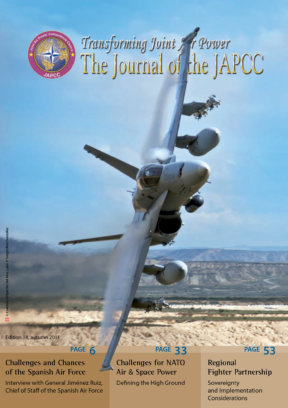Editorial
As the Director of the Joint Air Power Competence Centre, I am delighted to introduce the fall edition of the Journal. The Journal of the JAPCC prides itself on expressing Air and Space Power ideas and opinions through a diverse international authorship. This edition contains submissions from Australia, Germany, Italy, Poland, Spain, the United Kingdom, and the United States. I want to especially thank our contributors, and I hope you feel inspired to further debate the topics inside these pages. Your thoughts and ideas will help shape the future of Air and Space Power.
As the Alliance transitions to a new Air Command and Control structure, matures in Cyber and Space areas, and works to field a Ballistic Missile Defence system, there are clearly no lack of challenges. Meanwhile, national militaries face increasing fiscal constraints. As the overall size of NATO forces diminish, the significance of Air and Space effects increases. Against such an environment, it is as critical as ever to find tangible ways to maximise limited defence budgets. We must be more effective, work closer together, and find ways between nations to complement each other’s strengths. This edition explores some of the current hurdles, looks at Space from different perspectives, discusses a fighter consortium concept, and highlights a new Australian capability.
The first article is an interview with the Spanish Air Force Chief of Staff, General José Jiménez Ruiz. General Ruiz provides insight on upcoming Air and Space Power challenges as well as the next step forward in the evolution of Spanish military aviation.
Air Marshal Sir Chris Harper points out Space issues in today’s fight. Topography has played an important role in military endeavours as highlighted by Wellington and Napoleon. He suggests that ‘Space’ is the key high ground today.
Lt General Pasquale Preziosa of the Italian Air Force reminds us, ‘Today’s seed is tomorrow’s tree,’ and explains how flight schools are a key component to maintain Air Power effectiveness. Training on the right generation of aircraft augmented by realistic simulation is a balanced approach to achieving future air capability.
The JAPCC Regional Fighter Partnership Team, led by Col Dave Pedersen, discuss an option to share costs across common fighter aircraft capabilities, while still maintaining sovereign command.
Our partners ‘down under’ introduced a new Airborne Early Warning and Control (AEW&C) capability into the Royal Australian Air Force (RAAF). It is a capability similar to NATO AWACS. The RAAF’s ‘Wedgetail’ will be a truly joint capability with integration into the operations of the Navy and Army. Squadron Leader Simon Wildermuth takes us down the path to Initial Operational Capability (IOC).
Finally, the ‘Out of the Box’ piece invites readers to ponder whether NATO needs a Space policy.
Mark A. Welsh III
General, US AF
Director, JAPCC









